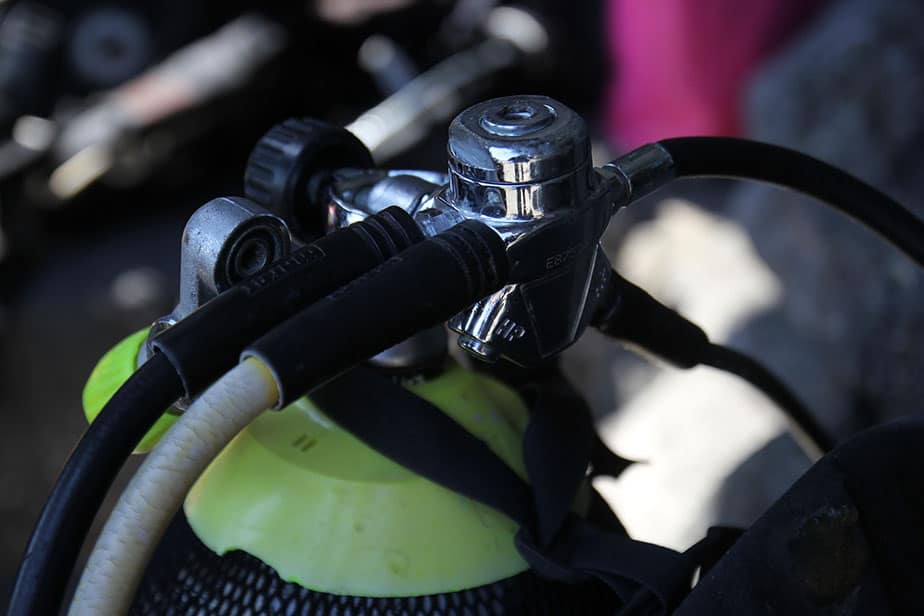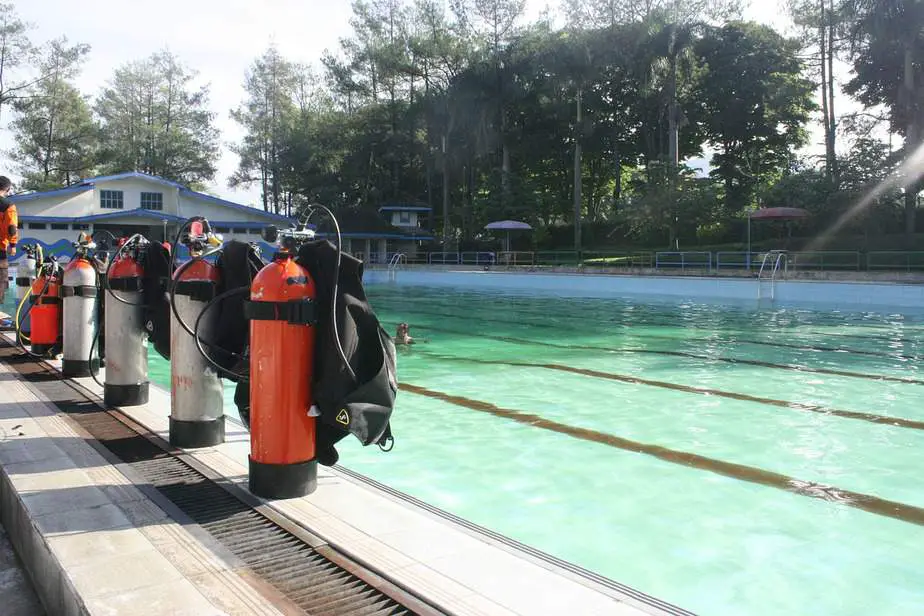Divers who use a different breathing gas other than standard air will need to use an oxygen analyzer to determine the exact oxygen percentage in their tank. As much as we’d like to trust that the person who filled and analyzed the tank did it carefully and properly, you can never be too safe when it comes to your safety. It doesn’t hurt to confirm it for yourself by using a nitrox analyzer.
The best nitrox analyzers will help you find the exact oxygen percentage is in a gas mix. If you’re a beginner who has only ever used standard air while diving, you may be wondering why this is important. Have you ever seen a gas tank with a bright yellow and green label that says “Enriched Air Nitrox” or simply “Nitrox”? That means the breathing gas inside has a higher percentage of oxygen than air which affects how long you can stay underwater.
It’s important that the oxygen percentage it says on the label matches up with what a nitrox analyzer says. It would be disastrous if you end up using a tank that has less oxygen than it claims it does, and end up exceeding your no-decompression limit (NDL) which puts you at risk of experiencing decompression sickness. With a reliable oxygen sensor, this will never happen and you can dive in peace. Continue reading to learn more about these devices and how to find the best ones.
Our Top Picks:
What does an oxygen analyzer do?
There’s nothing more important than the gas mix you’re breathing during a dive, and therefore it’s equally important that you use an oxygen analyzer to confirm you’re breathing what you think you’re breathing. Oxygen analyzers are typically portable and hand-held. With one, you can read the oxygen content in the tank to find out exactly how much oxygen is inside as a percentage (e.g. 21%).
Without getting too technical, oxygen analyzers, also known as nitrox analyzers, pull air from the tank where it reacts chemically with an agent, the oxygen sensor inside. The reaction will result in an electrical current that the oxygen sensor will read. The sensor will then tell you what exactly the gas mixture is composed of, and it should match the label on the tank.
While it may seem like a waste of time to double check the tank when the dive shop does a check for you, often multiple times before they sell it to you, you still can never be too sure. The one thing you can rely on a human to do is make a mistake, hence the saying, “to err is human.” And mistakes do happen. Why would you put your life entirely in someone else’s hands like that when you can do something about it?

Many dive shops will have oxygen analyzers on hand so you can confirm the blend of gas is what they say it is. With that said, it’s common procedure to use a nitrox analyzer on the tank you’re going to use before a dive. However, not all dive boats will have oxygen analyzers, so it’s best to have one of your own.
Even if you’re diving with standard air, you should still check the tank. Since air is supplied alongside nitrox, you must make sure that your tank hasn’t been mistakenly filled with nitrox. Make sure the oxygen percentage in air is 21%, nitrox will be anywhere from 22% to 40%.
On the boat, there may be multiple cylinders filled with all kinds of different blends which can be confusing. While they will all have labels, once again, it’s better to do a redundant check than it is to cross your fingers and pray everything will be alright during a dive. When it comes to nitrox, if the oxygen content is even off by 1% then you could potentially have problems later on.
How to use a nitrox analyzer
While the technology inside is complicated, modern oxygen analyzers are designed to be easy to use. Most come with an intuitive user interface, a couple of buttons, and of course, an inlet from which the nitrox analyzer can pull gas from the BCD or directly from the scuba cylinder. Remember to keep a few spare batteries around or to charge your device ahead of time so it’ll work when you need it to. Here’s a step-by-step process for how to use a nitrox analyzer:
- Calibrate your device. Each time you use the oxygen analyzer, you must calibrate it to ensure the readings are accurate. It doesn’t take very long to do so. For many analyzers, all you need to do is hold down the calibration button and it will calibrate itself.
- Open the valve on the cylinder. Let out a slow and steady stream of the breathing gas for a few seconds to get a consistent reading. Don’t open the valve too much otherwise you will waste a lot of breathing gas during the time it takes for the device to get a reading.
- Get your reading. Place the oxygen analyzer’s intake on the open valve for a few seconds. Don’t remove the analyzer until the reading stabilizes and you have your number.
- Check the numbers. Does the reading match the number on the label? Common oxygen amounts for nitrox are 32% and 36% oxygen, though the range can be anywhere from 22% to 40%. Check that it not only falls within that range, but that the number is exactly the same as what you planned your dive around. Otherwise, your NDL will be off and so will your other calculations.
See, that wasn’t too bad was it? And now you’re ready to dive.
In the next section, we’ll go over which nitrox analyzer models and brands are the best. In general, you should expect to spend at least a few hundred dollars for a reliable one. Furthermore, the oxygen sensor inside the analyzer will need to be replaced every 3 years, and that costs around $80 give or take. Without further ado, let’s analyze which ones are worth your money.
Best Oxygen Analyzers for Scuba Diving
Analox Oxygen Analyzer O2EII Pro
- Checks the quality of your diving gas mix
- BCD adaptor for convenient monitoring
- What's in the box: Analox O2EII Pro Nitrox Analyzer and Owner's Manual
This is a popular and compact nitrox analyzer often found on dive boats. Honestly, at this point it’s one of the gold standards of oxygen analyzers, having been around for well over a decade and still going strong.
You can use the O2EII Pro to check the tank’s oxygen content straight from the valve. Another option is to hook your tank up to your BCD and check the gas from the inflator hose. Using it is very straightforward. Wake it up by pressing any button. Then, calibrate it in air by turning a knob until it reaches the right percentage according to a compensation chart shown on the LCD screen.
Then all you need to do is point the sampling hemisphere of the device to the opened valve until the reading stabilizes. Nice and simple, which is why it’s one of the best. Additonally, the Analox oxygen analyzer is durable, portable, and a good purchase for anyone who is certified to dive nitrox.
Nuvair O2 Quickstick Oxygen Analyzer
- Easy to Calibrate
- Fast Response Time
- Replaceable Battery and Sensor
The Nuvair O2 Quickstick was designed with simplicity in mind. It’s highly portable and has a durable housing made of marine grade aluminum. Most analyzers are made of plastic, and therefore will feel quite cheap compared to the Nuvair. With its stick-like design, it barely takes up any space whether it’s in your pocket or luggage.
Calibrating this model is very straightforward. All you need to do is turn the end of the Quickstick until the machine reads 21% – then the device is prepped to analyze your tank.
Both the battery and the sensor on this device are replaceable, so if you have a hunch that your Quickstick is no longer making accurate readings, you can replace the sensor. Another advantage of this housing is that it’s water-resistant.
Not all oxygen analyzers are made for checking scuba cylinders, so they’ll deteriorate quickly on a dive boat, but not this product. You can’t go wrong with the Nuvair O2 Quickstick oxygen analyzer.
Palm D Oxygen Analyzer
- Palm O2 DOES NOT COME WITH CASE AS SHOWN
Yet another simple and straightforward analyzer that is around the same price as the other analyzers in our list, the Palm D oxygen analyzer is a portable and reliable device for testing nitrox. You can easily calibrate it with the press of a button, at either air (21%) or pure oxygen (100%).
The Palm D keeps its internal components protected with a secure housing, and the sensor will last around 3 years before needing a replacement. True to its name, the Palm D fits right in the palm of your hands. If you will be traveling a lot, its compact size makes it a great choice for a portable oxygen analyzer.
Forensics Detectors O2BOX Oxygen Analyzer
- ⚛️ DETECT: Large range 0% - 100% with 0.1% resolution. Made in Germany Honeywell 3 year sensor. Turn ON and GO.
- 🌷 ACCURATE: Electrochemical oxygen sensor with error < 0.2%.
- 🎆 DURABLE: Water Resistant Case protects analyzer with water resistant user manual.
The Forensics Detectors O2Box comes in a water-resistant, ABS plastic housing that will withstand heavy use on a dive boat. Its large rubber buttons are easy to press, and calibrating is as easy as pressing a single button and waiting 3 seconds. Its sensors can detect oxygen levels from 0% to 100%, and its accuracy rating is within a margin of error of only 0.2%.
Like the Palm D oxygen analyzer, the O2BOS is compact enough to fit into the palm of your hand. It takes 3 AAA batteries to power this device and that should last for 10 days of use. Some users have reported that the padding inside the case the O2BOX comes with can sometimes press a button and turn it on, draining its battery. You may have to remove some of the padding to prevent this from happening, otherwise the product itself is very reliable.
Parting words
As you can see, oxygen analyzers are very simple and compact devices that play an important role in ensuring your safety whether you’re diving nitrox or not. After checking your own tanks, you can dive with peace of mind knowing that the gas you’re breathing is really what you think it is.
As we mentioned, even a 1% difference in oxygen level will affect how long your NDL is. You don’t want to stay underwater for too long thinking you have more time when you should already be starting to ascend. You might accidentally turn your no-decompression dive into a decompression dive if you are breathing the wrong gas. By using an oxygen analyzer, you are further reducing your chances of having accidents while scuba diving.
Yes, oxygen analyzers will cost you a couple hundred dollars or more. However, this is one product you do not want to forgo.
Last update on 2025-08-28 / Affiliate links / Images from Amazon Product Advertising API





